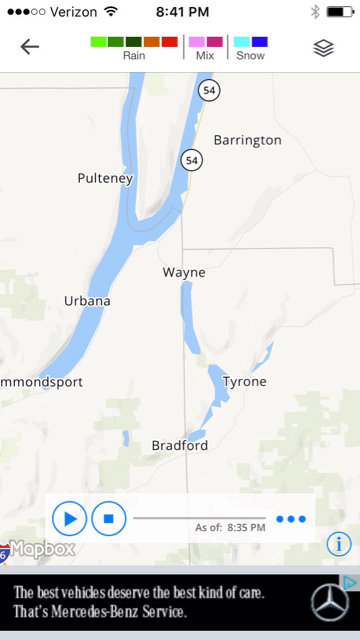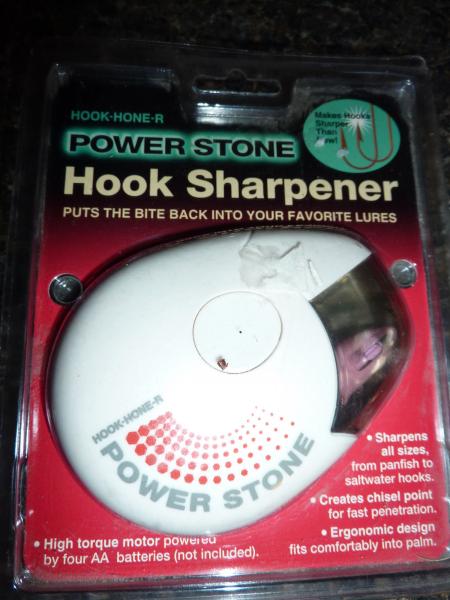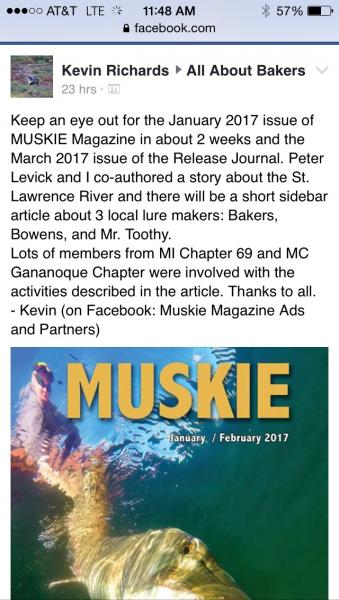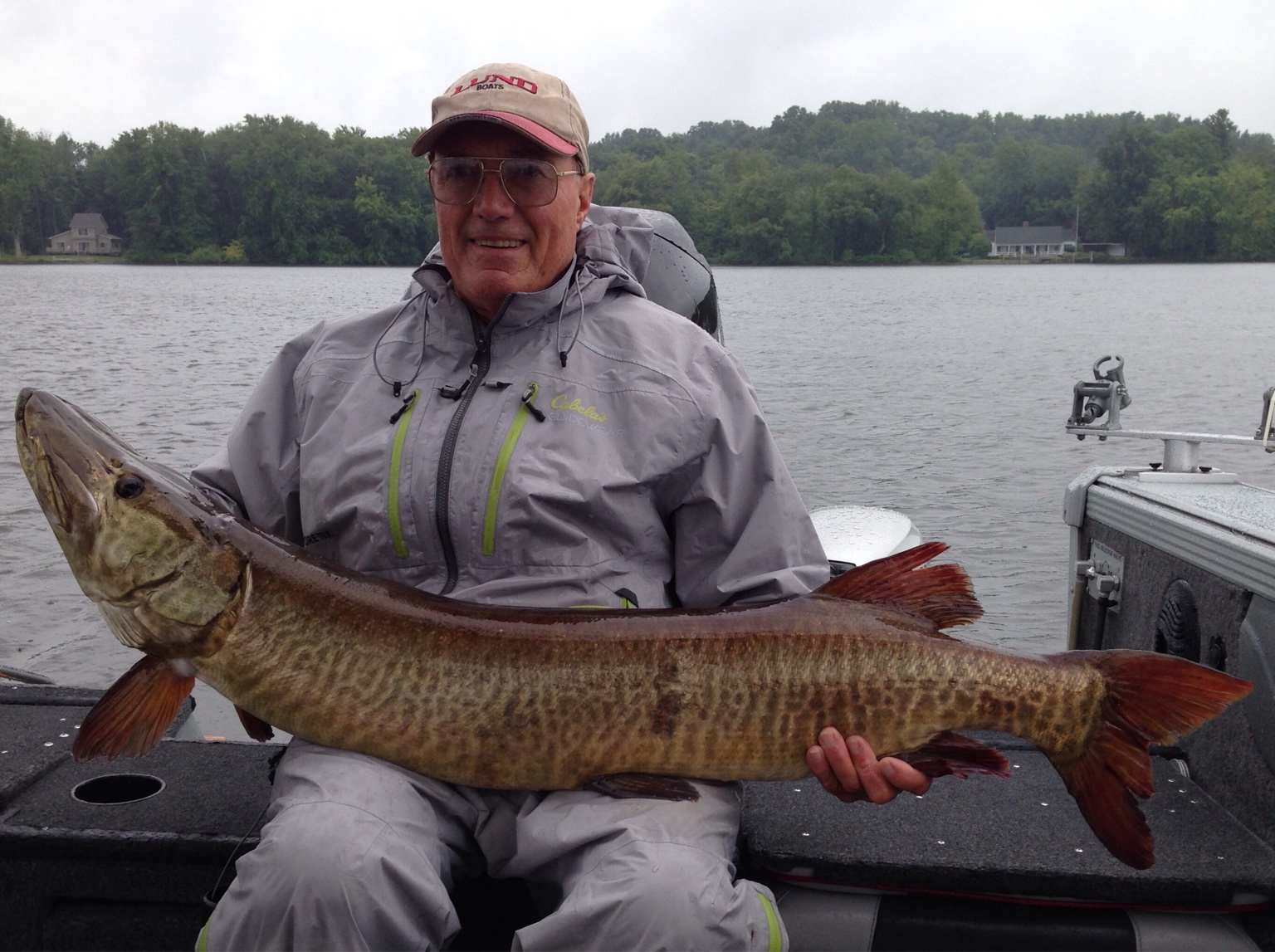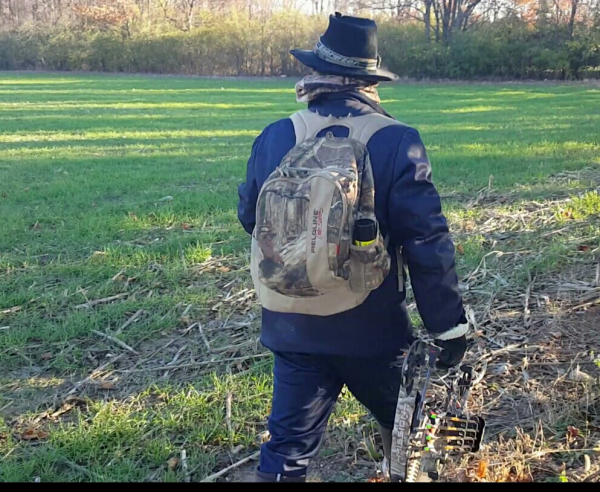-
Posts
1,067 -
Joined
-
Last visited
Content Type
Profiles
Forums
Events
Gallery
Store
Everything posted by muskiedreams
-
The ideal spawning habitat for each species is different. Muskies generally prefer slightly deeper water. A lot of preferred pike habitat in wetlands has degraded in the St. Lawrence due to reduced water fluctuations and invasive species. It has been said that as a result of that, and maybe some other factors, some pike have been spawning in more typical musky spawning sites which can cause the occurrence of naturally produced tiger muskies. There has been a a large project to restore some wetland habitat in the St. Lawrence. It is being funded mainly by the power plant re-licensing fees. They are opening up channels and shallow pools in the wetlands that were previously choked off so the pike can return to those pools to spawn. At the same time they are planting native aquatic vegetation. It has only been a year or two and they have already noted pike and many other species of fish birds and other aquatic species moving into the new habitat. This is a major project that is being managed and monitored by the Thousand Island Biological Research Station. In the Niagara River it may be a little different, especially in the East River. There is a very limited amount of muskie spawning habitat. Shipping and other shoreline development over the years has eliminated a great deal of the natural spawning habitat. There is a considerable ongoing effort to bring back more natural shoreline habitat in the Niagara River, Buffalo River and Buffalo Harbor. Much of it is also being funded by the NYSEG re-licensing fees.
-

Musky Chapter Clayton/Cape Vincent?
muskiedreams replied to Prof T's topic in Musky, Tiger Musky & Pike (ESOX)
There is the Gananoque Chapter of Muskies Canada which is the closest. There is also Muskies Inc. New York Chapter 69. Chapter 69 is the only chapter in NY. We started in Rochester in 2012 and about 15 to 18 members are in the Rochester area where we have our meetings. The rest of the members are scattered all around the state. Some in the Syr. and Adirondack area. Some in the Finger Lakes and Southern Tier. Some in the Buffalo area, Chautauqua area, Erie PA. Even one in Ohio and one in MA. There is one other club in Buffalo, the Niagara Muskie Association. They are a great club and have been around many years. Their focus is mainly on the Niagara River and eastern Lake Erie. They have had a lot of great accomplishments in that area. There are also members of each club that belong to another and at least one who belongs to all 3. -

Tying a flouro leader to braid (casting)
muskiedreams replied to justtracytrolling's topic in Bass Fishing
Interesting knot. I found this animation and it made it look very difficult and unclear how to do it. http://www.netknots.com/fishing_knots/fg-knot I then found this video which makes it look very clear and fairly easy to do. https://www.youtube.com/watch?v=pjzUb5QRKuk As usual on utube, there are other videos that come up and there are variations in each one. Several use different numbers of half hitches on both lines and then the main line and several finish it off with a double or triple half hitch. There are even some that have a tool they claim makes it easier. -
A sharp hook should stick to your fingernail instead of sliding across it. Most new hooks do not. If it doesn't, it isn't sharp. Having sharp hooks is arguably the most important factor in strike to hookup ratio. They can become a little dull over time (due to oxidation) or from contacting structure. It is a good idea to check them often, especially after missing a fish or contacting structure. They also need to have a nice gradual taper for deep and easy penetration. So they can only be sharpened so many times before they need to be replaced. Becoming experienced at using a good flat hook file is the best way to go. Using a power tool can heat up the very point of the hook and compromise the hardness of the steel.
-

Jan/ issue Muskie magazine!
muskiedreams replied to solgrande's topic in Musky, Tiger Musky & Pike (ESOX)
I just finished reading the article. Excellent article. Peter and Kevin did a great job on it. It really brings to mind how delicate the fishery is. I would like to see the article published elsewhere for more awareness. I am hoping that through research they will be able to find a way to reduce the impact of the gobies and VHSV. Since there has just been an agreement to change the water level management practices, it will be interesting to see if it improves spawning success. There is however, a lot of concern and opposition from lake shore communities and businesses about flooding and about low water conditions in harbors. I haven't heard any detail about how they are going to manage those concerns. -

favorites casting lures for Musky
muskiedreams replied to NPike's topic in Musky, Tiger Musky & Pike (ESOX)
This is just some very basic stuff. I don't understand what you disagree with. There are some NMA members who are very successful using jigs. I have had some success with them. Also, about 5 years ago I netted a 50"r caught on a tube and took the picture of another 50"r a couple weeks later that was caught on a Swim Shad. If you look at the NMA catch and release logs for the last 8 to 10 years, ROB tubes have been one of the top baits, and for at least 2 or 3 of those years, the top bait. -
You might want to see what filters you have check marked in the left column. If you have the one checked under "Other", that is all you will see.
-
They have spent millions on Bradocks Bay restoring the wetlands as well as work on the bay to improve navigation in order to make the marinas usable again. What affect will this have there. Has much of that money spent there just gone to waste?
-

favorites casting lures for Musky
muskiedreams replied to NPike's topic in Musky, Tiger Musky & Pike (ESOX)
-

favorites casting lures for Musky
muskiedreams replied to NPike's topic in Musky, Tiger Musky & Pike (ESOX)
Jigging can be very productive. They can be jigged or dragged in river current 12' to 25'. You must be prepared to loose a few to snags and have a heavy baitcaster with min. 50 lb braid. They can also be cast and jerked around cover or shallow flats. There are various ways to rig them for each task. You can use your imagination. Keep in mind that you will loose more fish while jigging than casting or trolling but the potential to hook more fish is there. Red October Tubes, Storm Swim Shads and Bondy Baits are all good choices. There are variations on all these in rigging techniques and presentation, depending on applications, that will help increase catch rates. You will need to do your homework on that. -

favorites casting lures for Musky
muskiedreams replied to NPike's topic in Musky, Tiger Musky & Pike (ESOX)
-

Old musky inc/Chautauqua lake tournament!
muskiedreams replied to John Edward's topic in Musky, Tiger Musky & Pike (ESOX)
-
Thanks for stating this Mike. I wish I could find some estimates on stocking size, quantities and survival rates to size ranges. I know I have seen such studies but I am sure it can only be so accurate and vary widely depending on the body of water and it's unique circumstances. I know that the survival rates are very low and increases greatly by size range. When you see those estimates, it puts int perspective how special even a 35 inch fish is. I do know that the number of naturally reproduced fish in Waneta is very low. When they stock a musky from the Chautauqua hatchery, they clip one of the pectoral or ventral fins. A naturally spawned fish will not have a clipped fin. I don't know if they might have missed clipping a few stocked fish though.
-
Yes, I know that I would be surprised if there are any bait shops that have large certified suckers. Also, I can only imagine how much they would cost. $19.99 each? $39.99 each?
-
There are all kinds or regs about transportation of live bait and fish between bodies of water. So technically, you would probably have to catch them from the waters you are using them in or they would have to be certified somehow.
-
Because of the nature of the breed, being that they are slow growing, any musky fishery can suffer from an adverse event. I think it is more important for us to promote proper CPR but also not bash someone if they do it wrong or for keeping a fish within the law. You will never change them by yelling at them. It is also possible that several year classes can suffer from event or a string of less than ideal growing seasons. Since the DEC does not do seining or trap netting there very often, all of you who care about the fishery and fish there at least once per year should consider helping them out with data collection by participating in their yearly diary study if you are not already participating. This not only helps them with data that can be used to better assess the health of the fishery, it also helps them to justify with Albany that the investment in the lake(s) is worthwhile. This is also true with all fisheries in the state and all species of fish. This information can not only be used to help monitor the health of the fisheries in the state but also help to determine where and how resources could be best utilized and create the best return for the state and fishing opportunities for residents. It would be nice if the state could come up with a statewide diary study that would work. I have seen the subject come up in the past but I think the biggest concern that they have is making sure the data is accurate. I can understand the concern there. One thing we can do here on the LOU community is to help promote and expand the Anger Diary Study program here and through the various clubs and organization that we participate in. It must be done in such a way so that those who participate will be diligent in documenting every one of their fishing trips. There are diary studies being conducted on many waters by regional DEC offices. I have diaries for three fisheries to fill out. I could add at least two more but I may only visit each of these fisheries once or maybe not at all in a season. As it is, there is one that I sent back last year with no new entries and it will be the same this year. But I could conceivably fish there two or three times next year. Sometimes I wonder if it makes sense to fill out a diary if I only fished there once in a season. I can say that I would much rather have one diary to fill out where I can enter all my fishing trips for the season. I just wonder if it could be done and still keep the data accurate somehow. Maybe it could be done if we can present a practical plan to the DEC. I don't know if there is a way to conduct a poll here on LOU but I would be curious to find out if more anglers would participate in an angler diary study and diligently provide accurate data if they could do it all in one diary.
-
-
-
-
Bob, Jim has all the submission forms. I can send emails to John Haffner to see if he or his fishing partner can send a picture of the 51.5" fish and to Dan to and ask him to send pictures of the three fish he caught and also to Ed Cragg to see if he or his client can send pictures of those fish.
-
There were 18 anglers and 8 fish submitted.
-
Picture is taken of measurement and witnessed by other participant on boat. Also a picture of angler with fish, usually. For a tournament with substantial prizes, you can also have an object such as a sticker or pin that is issued to participants at the start of the tournament which must be in the picture.
-
Dan Lacko took 1st place with 3 fish. Largest he had was 47". There was a tie for 2nd place with 26 points. I don't have the names of those two. They agreed to add 2nd and 3rd place prizes and split the amount. One of them had the largest fish, and won the big fish pool, which was a beautiful 51.5 " fish (rounded up to 52" for points). He was John Hafner's partner. The other angler caught 2 fish for the same number of points. He was fishing with Capt. Ed Cragg. His first fish and the big fish caught by the other angler were both caught at 8:30 am.
-
I am wondering the same thing. Jim and I have to be at the launch at 6am to sign people up. Hope it is worthwhile. I believe one team is coming from the Chautauqua area. That is all I know of so far. We were there on Wednesday. We had the lake to ourselves. It was dead calm with water temp. of 52* to 53*. Saw one big swirl and a few nice hooks but no takers except an over ambitious 10" perch. BlueEye might not be there unless he is planning on a double header. I think he is fishing with Joe in the NMA TWMT on the Niagara on Sunday.
-
It is Allegheny Reservoir, part of the Allegheny River. I believe they get muskies in the river in PA. Popular for muskies on the fly. I am not sure about the Reservoir or the NY portion of the river.


